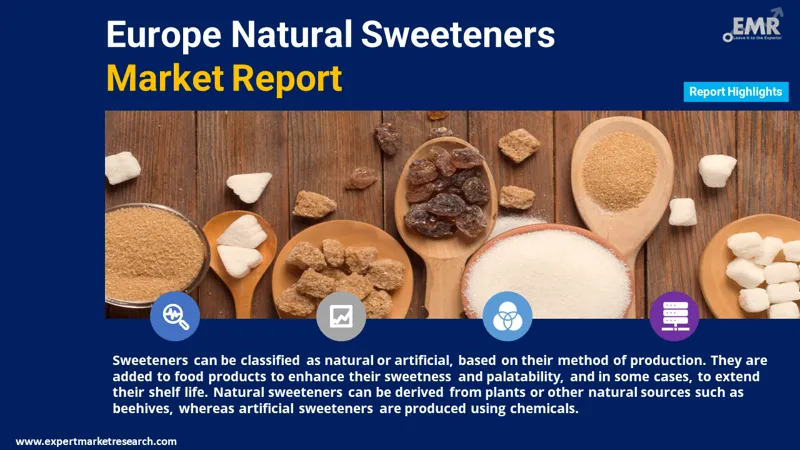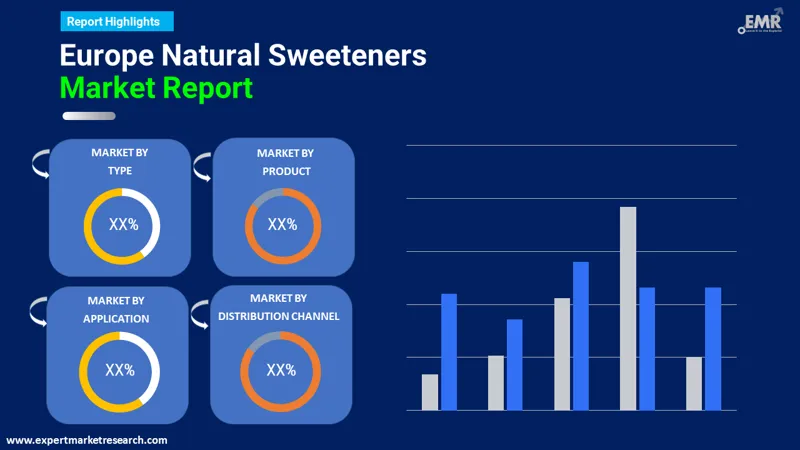
Consumer Insights
Uncover trends and behaviors shaping consumer choices today
Procurement Insights
Optimize your sourcing strategy with key market data
Industry Stats
Stay ahead with the latest trends and market analysis.
The Europe natural sweeteners market was valued at USD 5.57 Billion in 2025. The industry is expected to grow at a CAGR of 7.10% during the forecast period of 2026-2035 to attain a valuation of USD 11.06 Billion by 2035.
Base Year
Historical Period
Forecast Period
Compound Annual Growth Rate
7.1%
Value in USD Billion
2026-2035
*this image is indicative*
Europe is a leader in the stevia market after the Asia Pacific. The two regions, together account for more than three-fifth of the total global market share. Stevia extracts were approved for use in the European Union in November 2011, and since then there has been a rapid increase in the production of items containing stevia, particularly in food and beverage sector in Europe. France holds a strong position in the European stevia market for the country approved the use of stevia sweeteners, particularly the Reb A strain, from 2009 onwards. In Europe, several big brands like Coca-Cola have started reformulating existing products and manufacturing new ones upon seeing an increasing demand for stevia among consumers.
Europe is dependent on imports from other countries to meet the growing stevia demand in the natural sweeteners industry as stevia leaves are not native to Europe. China, being the major producer of stevia, serves as the leading stevia supplier to Europe. The countries like Germany and France, with the biggest food industries, are the major consumers of natural sweeteners and, thus, emerge as a major destination for stevia exportation in Europe.

Read more about this report - REQUEST FREE SAMPLE COPY IN PDF
Sweeteners can be natural or artificial based on the way it is produced. They are added to the food products to increase their palatability or sweetness and sometimes, to increase their shelf-life. Natural sweeteners can be obtained from plants or some other natural source like beehives unlike artificial sweeteners, which are manufactured using chemicals. The natural sweeteners products produced in the region can be categorised as follows:
Market Breakup by Type
Market Breakup by Product
Market Breakup by Application
Market Breakup by Distribution Channel
Market Breakup by Region

Read more about this report - REQUEST FREE SAMPLE COPY IN PDF
In the historical period, after the approval of stevia in the European Union, the natural sweeteners industry in Europe witnessed a healthy growth. Now, with the increasing health consciousness among consumers and the rise in demand for low-calorie products, the industry has seen a further growth.
The increasing rates of obesity and type 2 diabetes has fuelled the demand for low-sugar or sugar-free sweeteners in the region. In the food and beverage sector, the demand for sports and energy drinks has increased, further influencing the companies to manufacture it using the zero-calorie sweetener, like stevia. Also, the use of organic products is on the rise, thus, driving the industry further. The companies like Coca-Cola reformulated existing products like Sprite, catering to the demand of consumers to produce stevia-based products. Also, with the success of stevia in France the company launched several new products like Coca-Cola Life, Goba cola, and Activia Fat Free, which are stevia based, thus, aiding the Europe natural sweeteners market.
Moreover, the increase in the demand for natural sweeteners in the pharmaceutical sector is emerging as a key factor, further propelling the industry forward. Natural sweeteners are used to manufacture toothpastes and health supplements. Also, its use in the production of cosmetics has increased, which will enhance the industry growth in the coming years.
The EMR report gives a detailed analysis of the following key players in the Europe natural sweeteners market, covering their competitive landscape and recent developments like mergers and acquisitions, investments, capacity expansion, and plant turnarounds:
The report provides an in-depth analysis of the industry based on SWOT and Porter’s five forces analysis.
Latin America Natural Sweeteners Market
Asia Pacific Natural Sweeteners Market




*While we strive to always give you current and accurate information, the numbers depicted on the website are indicative and may differ from the actual numbers in the main report. At Expert Market Research, we aim to bring you the latest insights and trends in the market. Using our analyses and forecasts, stakeholders can understand the market dynamics, navigate challenges, and capitalize on opportunities to make data-driven strategic decisions.*
Get in touch with us for a customized solution tailored to your unique requirements and save upto 35%!
In 2025, the market attained a value of nearly USD 5.57 Billion.
The market is assessed to grow at a CAGR of 7.10% between 2026 and 2035.
The market is estimated to witness a healthy growth in the forecast period of 2026-2035 to reach about USD 11.06 Billion by 2035.
The major drivers of the market include rising disposable incomes, increasing population, increasing awareness and health consciousness, and rising demand for sugar-substitutes with low-calorie content.
The growing shift toward organic food products is a major trend influencing the market growth positively.
The major regions in the market include Germany, France, United Kingdom, Italy, and Netherlands among others.
The major product types in the market are stevia, maple syrup, honey, molasses, and coconut sugar, among others.
These sweeteners are available in two types, low intensity sweeteners and high intensity sweeteners.
The food and beverages segment is the leading application segment in the market.
The significant distribution channels of the product are hypermarkets/supermarkets, convenience stores, special stores, and online retailers, among others.
The major players in the market are Tereos Starch and Sweeteners, Cargill, Incorporated, Ingredion Inc., Tate & Lyle, and PureCircle, among others.
Explore our key highlights of the report and gain a concise overview of key findings, trends, and actionable insights that will empower your strategic decisions.
| REPORT FEATURES | DETAILS |
| Base Year | 2025 |
| Historical Period | 2019-2025 |
| Forecast Period | 2026-2035 |
| Scope of the Report |
Historical and Forecast Trends, Industry Drivers and Constraints, Historical and Forecast Market Analysis by Segment:
|
| Breakup by Type |
|
| Breakup by Product |
|
| Breakup by Application |
|
| Breakup by Distribution Channel |
|
| Breakup by Region |
|
| Market Dynamics |
|
| Competitive Landscape |
|
| Companies Covered |
|
| Report Price and Purchase Option | Explore our purchase options that are best suited to your resources and industry needs. |
| Delivery Format | Delivered as an attached PDF and Excel through email, with an option of receiving an editable PPT, according to the purchase option. |
Datasheet
One User
USD 2,499
USD 2,249
tax inclusive*
Single User License
One User
USD 3,999
USD 3,599
tax inclusive*
Five User License
Five User
USD 4,999
USD 4,249
tax inclusive*
Corporate License
Unlimited Users
USD 5,999
USD 5,099
tax inclusive*
*Please note that the prices mentioned below are starting prices for each bundle type. Kindly contact our team for further details.*
Flash Bundle
Small Business Bundle
Growth Bundle
Enterprise Bundle
*Please note that the prices mentioned below are starting prices for each bundle type. Kindly contact our team for further details.*
Flash Bundle
Number of Reports: 3
20%
tax inclusive*
Small Business Bundle
Number of Reports: 5
25%
tax inclusive*
Growth Bundle
Number of Reports: 8
30%
tax inclusive*
Enterprise Bundle
Number of Reports: 10
35%
tax inclusive*
How To Order

Select License Type
Choose the right license for your needs and access rights.

Click on ‘Buy Now’
Add the report to your cart with one click and proceed to register.

Select Mode of Payment
Choose a payment option for a secure checkout. You will be redirected accordingly.
Gain insights to stay ahead and seize opportunities.

Get insights & trends for a competitive edge.

Track prices with detailed trend reports.

Analyse trade data for supply chain insights.

Leverage cost reports for smart savings

Enhance supply chain with partnerships.

Connect For More Information
Our expert team of analysts will offer full support and resolve any queries regarding the report, before and after the purchase.
Our expert team of analysts will offer full support and resolve any queries regarding the report, before and after the purchase.
We employ meticulous research methods, blending advanced analytics and expert insights to deliver accurate, actionable industry intelligence, staying ahead of competitors.
Our skilled analysts offer unparalleled competitive advantage with detailed insights on current and emerging markets, ensuring your strategic edge.
We offer an in-depth yet simplified presentation of industry insights and analysis to meet your specific requirements effectively.
Share